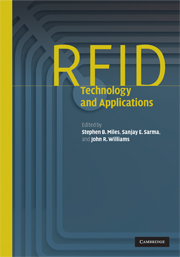Book contents
- Frontmatter
- Contents
- List of contributors
- Preface
- Acknowledgments
- 1 Introduction to RFID history and markets
- 2 RFID technology and its applications
- 3 RFID tag performance optimization: a chip perspective
- 4 Resolution and integration of HF and UHF
- 5 Integrating sensors and actuators into RFID tags
- 6 Performance evaluation of WiFi RFID localization technologies
- 7 Modeling supply chain network traffic
- 8 Deployment considerations for active RFID systems
- 9 RFID in the retail supply chain: issues and opportunities
- 10 Reducing barriers to ID system adoption in the aerospace industry: the aerospace ID technologies program
- 11 The cold chain
- 12 The application of RFID as anti-counterfeiting technique: issues and opportunities
- 13 Closing product information loops with product-embedded information devices: RFID technology and applications, models and metrics
- 14 Moving from RFID to autonomous cooperating logistic processes
- 15 Conclusions
- Appendix – links to RFID technology and applications resources
- Editor biographies
- Index
- References
6 - Performance evaluation of WiFi RFID localization technologies
Published online by Cambridge University Press: 02 November 2009
- Frontmatter
- Contents
- List of contributors
- Preface
- Acknowledgments
- 1 Introduction to RFID history and markets
- 2 RFID technology and its applications
- 3 RFID tag performance optimization: a chip perspective
- 4 Resolution and integration of HF and UHF
- 5 Integrating sensors and actuators into RFID tags
- 6 Performance evaluation of WiFi RFID localization technologies
- 7 Modeling supply chain network traffic
- 8 Deployment considerations for active RFID systems
- 9 RFID in the retail supply chain: issues and opportunities
- 10 Reducing barriers to ID system adoption in the aerospace industry: the aerospace ID technologies program
- 11 The cold chain
- 12 The application of RFID as anti-counterfeiting technique: issues and opportunities
- 13 Closing product information loops with product-embedded information devices: RFID technology and applications, models and metrics
- 14 Moving from RFID to autonomous cooperating logistic processes
- 15 Conclusions
- Appendix – links to RFID technology and applications resources
- Editor biographies
- Index
- References
Summary
In the chapter that follows a test methodology is proposed for evaluating active RFID systems performance with wireless localization technology. While the problem of locating objects has been largely addressed for outdoor environments with such technologies as GPS, for indoor radio propagation environments the location problem is recognized to be very challenging, due to the presence of severe multipath and shadow fading. Several companies are now developing products to use RFID technology together with traditional localization techniques in order to provide a solution to the indoor localization problem. However, the performance of such systems has been found to vary widely from one indoor environment to another. A framework and design for a real-time testbed for evaluating indoor RFID positioning systems is described.
Historically radio direction-finding is the oldest form of radio navigation. Before 1960 navigators used movable loop antennas to locate commercial AM stations near cities. In some cases they used marine radiolocation beacons, which share a range of frequencies just above AM radio with amateur radio operators. LORAN (LOng RAnge Navigation) systems also used time-of-flight radio signals, from radio stations on the ground, whereas VOR (VHF omnidirectional range) systems in aircraft use an antenna array that transmits two signals simultaneously. The UWB two-way time transfer technique allows even more accurate calculation of distances for location tracking. Choices for in-building tracking systems are covered in the following chapter, including angle of arrival (AOA), received signal strength (RSS), time of arrival (TOA), and time difference of arrival (TDOA).
- Type
- Chapter
- Information
- RFID Technology and Applications , pp. 74 - 86Publisher: Cambridge University PressPrint publication year: 2008

